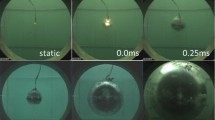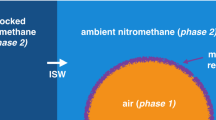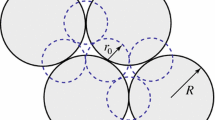Abstract
The dynamics of detonation initiated by the shock-induced collapse of a gas-filled ellipsoidal cavity embedded in a condensed-phase explosive is examined computationally. Attention is focused on the details of the evolutionary process following the collapse. The reaction rate is assumed to be pressure-dependent, switching on when the pressure exceeds an ignition threshold. The strength of the incident shock is taken to be such that the reaction would not be initiated without the interaction of the shock with the cavity. The system is modeled as a multi-material mixture, and a high-resolution, Godunov-type scheme is employed to solve the governing equations numerically. The computations are carried out in parallel, and adaptive mesh refinement is used to obtain accurate and well-resolved solutions. It is found that collapse of the cavity produces a detonation provided that the cavity is large enough, or the rate of reaction strong enough; otherwise any reaction initiated by the collapse fizzles out. Details of how the detonation is established are found to depend strongly upon the shape of the cavity.
























Similar content being viewed by others
References
Abgrall, R.: How to prevent pressure oscillations in multicomponent flow calculations: a quasi conservative approach. J. Comput. Phys. 125, 150–160 (1996)
Ball, G.J., Howell, B.P., Leighton, T.G., Schofield, M.J.: Shock-induced collapse of a cylindrical air cavity in water: a free-Lagrange simulation. Shock Waves 10, 265–276 (2000)
Banks, J.B., Schwendeman, D.W., Kapila, A.K., Henshaw, W.D.: A study of detonation propagation and diffraction with compliant confinement. Combust. Theory Model. 12, 769–808 (2008)
Bourne, N.K.: On the collapse of cavities. Shock Waves 11, 447–455 (2002)
Bourne, N.K., Field, J.E.: Explosive ignition by the collapse of cavities. Proc. R. Soc. Lond. A 455, 2411–2426 (1999)
Bourne, N.K., Milne, A.M.: On cavity collapse and subsequent ignition. In: The Twelfth Symposium (International) on Detonation, pp. 213–219 (2002)
Bourne, N.K., Milne, A.M.: The temperature of a shock-collapsed cavity. Proc. R. Soc. Lond. A 459, 1851–1861 (2003)
Clutter, J.K., Belk, D.: Simulation of detonation wave interaction using an ignition and growth model. Shock Waves 12, 251–263 (2002)
Henshaw, W.D.: Overture: An Object-Oriented Toolkit for Solving Partial Differential Equations in Complex Geometries. http://www.overtureframework.org/. Accessed 26 Aug 2015
Henshaw, W.D., Schwendeman, D.W.: An adaptive numerical scheme for high-speed reactive flow on overlapping grids. J. Comput. Phys. 191(2), 420–447 (2003)
Henshaw, W.D., Schwendeman, D.W.: Parallel computation of three-dimensional flows using overlapping grids with adaptive mesh refinement. J. Comput. Phys. 227, 7469–7502 (2008)
Kapahi, A., Udaykumar, H.S.: Dynamics of void collapse in shocked energetic materials: physics of void–void interaction. Shock Waves 23, 537–558 (2013)
Kapila, A.K., Schwendeman, D.W., Bdzil, J.B., Henshaw, W.D.: A study of detonation diffraction in the ignition-and-growth model. Combust. Theory Model. 11, 781–822 (2007)
Lauer, E., Hu, X.Y., Hickel, S., Adams, N.A.: Numerical investigation of collapsing cavity arrays. Phys. Fluids 24, 052104 (2012)
Michael, L., Nikiforakis, N.: The temperature field around collapsing cavities in condensed-phase explosives. In: The Fifteenth Symposium (International) on Detonation, pp. 60–70 (2014)
Ozlem, M., Schwendeman, D.W., Kapila, A.K., Henshaw, W.D.: A numerical study of shock-induced cavity collapse. Shock Waves 22, 89–117 (2012)
Saurel, R., Abgrall, R.: A simple method for compressible multifluid flows. SIAM J. Sci. Comput. 21(3), 1115–1145 (1999)
Schwendeman, D.W., Kapila, A.K., Henshaw, W.D.: A study of detonation diffraction and failure for a model of compressible two-phase reactive flow. Combust. Theory Model. 14, 331–366 (2010)
Schwendeman, D.W., Kapila, A.K., Henshaw, W.D.: A hybrid multiphase mixture model of detonation diffraction with compliant confinement. C. R. Mec. 340, 804–817 (2012)
Schwendeman, D.W., Wahle, C.W., Kapila, A.K.: The Riemann problem and a high-resolution Godunov method for a model of compressible two-phase flow. J. Comput. Phys. 212, 490–526 (2006)
Schwendeman, D.W., Wahle, C.W., Kapila, A.K.: A study of detonation evolution and structure for a model of compressible two-phase reactive flow. Combust. Theory Model. 12, 159–204 (2008)
Souers, P.C., Garza, R., Vitello, P.: Ignition and growth and JWL++ detonation models in course zones. Propellants, Explos. Pyrotech. 27, 62–71 (2002)
Swantek, A.B., Austin, J.M.: Collapse of void arrays under stress wave loading. J. Fluid Mech. 649, 399–427 (2010)
Tarver, C.M.: Corner turning and shock-desensitization experiments plus numerical modeling of detonation waves in triaminonitrobenzene-based explosive LX-17. J. Phys. Chem. A 114, 2727–2736 (2010)
Tarver, C.M., McGuire, E.M.: Reactive flow modeling of the interaction of TATB detonation waves with inert materials. In: The Twelfth International Symposium on Detonation, pp. 641–649 (2002)
Toro, E.F.: Riemann Solvers and Numerical Methods for Fluid Dynamics. Springer, Berlin (1999)
Tran, L.B., Udaykumar, H.S.: Simulations of void collapse in an energetic material, part I: inert case. J. Propuls. Power 22, 947–958 (2006)
Tran, L.B., Udaykumar, H.S.: Simulations of void collapse in an energetic material, part II: reactive case. J. Propuls. Power 22, 959–974 (2006)
Acknowledgments
The codes employed for this paper may be obtained online at the Overture website [9]. Research support was provided by the National Science Foundation under grant DMS-1016188 for DWS and AKK, and by Los Alamos National Laboratory under contract 136603 for DWS, AKK, and JRG. Additional support for DWS was given by Lawrence Livermore National Laboratory (LLNL) under contract B597595. The work of WDH was performed under the auspices of the U.S. Department of Energy (DOE) by LLNL under contract DE-AC52-07NA27344 and by DOE contracts from the ASCR Applied Math Program.
Author information
Authors and Affiliations
Corresponding author
Additional information
Communicated by F. Zhang.
Appendix
Appendix
We consider the structure of a planar, Chapman–Jouguet detonation in the solid. Assuming that the detonation is propagating at speed D into a stationary state characterized by the suffix 1, conservation of mass, momentum, and energy provide the conditions:
Here, h is the enthalpy given by
for the equation of state in (5) with \(q=q_\mathrm{s}\) for the solid. We note that
since \(\lambda =0\) and \(\mathbf {w}=\mathbf {w}^{(u)}\) at state 1. Now, (12) and (13) yield
Elimination of u from (9) and (10) provides the Rayleigh line
where \(J=\rho _1D\) is the mass flux through the steady detonation wave. Elimination of u between (9) and (11) leads to
and then, the use of (15) to eliminate J yields
By virtue of (14), (16) transforms into
which specifies a family of Hugoniot curves, parameterized by \(\lambda \). To find the intersection of the Rayleigh line and a Hugoniot curve for any choice of \(\lambda \), we eliminate \(\rho \) between (15) and (17) to get
On setting \(P=p-p_1\), (18) can be rearranged into the quadratic
Here we have replaced J in favor of \(D=J/\rho _1.\) For a specified D the appropriate solution of this quadratic yields the pressure increment \(P= p-p_1\) as a function of \(\lambda .\) With P known, the original conservation conditions determine the other state variables, \(\rho \) and u.
1.1 The CJ state
At the CJ point the two roots of the quadratic in (19) are equal when \(\lambda \) is set to 1. We note that \(\mathbf{w}=\mathbf{w}^{(r)}\) at \(\lambda =1.\) Therefore (19) reduces to
where \(\varDelta w_j=w^{(r)}_j-w^{(u)}_j\), \(j=1\) or 2. The equal-root condition
determines the CJ speed \(D_{\mathrm{CJ}}.\) We define
so that (21) condenses into
and yields the root \(D_{\mathrm{CJ}}\) as
Once \(D_{\mathrm{CJ}}\) is known, (20) determines \(P_{\mathrm{CJ}}\) to be
Then,
and the CJ state is completely determined.
We are interested, in particular, at the CJ detonation propagating in the region \({\tilde{\varOmega }}_\mathrm{s}\) behind the incident shock; see Fig. 1. The density and pressure in that region are given in Table 1. The von-Neumann and CJ states associated with the detonation are listed in Table 2.
1.2 Reaction-wave structure
The structure of the reaction zone for wave speed \(D_{\mathrm{CJ}}\) is determined by the traveling-wave version of the rate law,
where \(\mathscr {R}\) is the pressure-dependent reaction rate defined in (4). We shall assume that the pressure at the end of the reaction zone exceeds the pressure threshold \(p_{\mathrm{ign}}\) so that the reaction is not extinguished prior to complete consumption of the reactant. Integration of (23) requires p and u to be known functions of \(\lambda .\) The expression for \(p(\lambda )\) comes from solving the quadratic (19) with \(D=D_{\mathrm{CJ}}\), which can be expressed concisely as
where
In these equations, \(\mathbf {w} = (1-\lambda )\mathbf{w}^{(u)}+ \lambda \mathbf{w}^{(r)}.\) Based on the results for an ideal gas, one expects \(b(\lambda )\) to be positive and \(c(\lambda )\) to be monotonically increasing from zero as \(\lambda \) increases through the reaction zone from zero to unity. The quadratic for P has the roots
We choose the plus sign, which corresponds to a shock at the head of the reaction zone and a decreasing pressure through the reaction zone. With P known, \(p=p_1+P\) yields the pressure p and then, u is given by
One is now in a position to integrate (23) for \(\lambda (x).\) The resulting structure appears in Fig. 25, as the graph of \(\lambda \) against the scaled spatial coordinate \(\sigma x\). We note, from the figure, that the dimensionless reaction-zone length \(x_{\mathrm{rz}}\) is given by
where we have assigned the end of the reaction zone to correspond to \(\lambda =0.99\).
Rights and permissions
About this article
Cite this article
Kapila, A.K., Schwendeman, D.W., Gambino, J.R. et al. A numerical study of the dynamics of detonation initiated by cavity collapse. Shock Waves 25, 545–572 (2015). https://doi.org/10.1007/s00193-015-0597-9
Received:
Revised:
Accepted:
Published:
Issue Date:
DOI: https://doi.org/10.1007/s00193-015-0597-9





